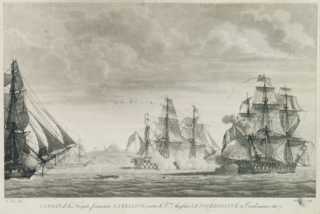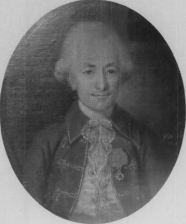Biography
Cillart was born in an aristocratic family. His father was captain in a dragoon unit, and two of his brothers, Étienne-François de Cillart de Villeneuve and Armand-François Cillart de Suville, also served in the Navy.
Cillart joined the Navy as a Garde-Marine on 19 March 1756. He was promoted to Lieutenant on 1 October 1773, and to Captain on 4 April 1780, effective 9 May 1781.
Cillart captained the frigate 32-gun frigate Surveillante, part of the Expédition Particulière under Admiral Ternay, composed of 7 ships of the line, [Note 1] 3 frigates [Note 2] and 36 transports. Surveillante, as vanguard of the squadron, arrived at Boston on 11 June 1780.
From then on, Surveillante was attached to the Ternay's squadron as part of a frigate division Cillart, with his flag on Surveillante, and also comprising Amazone and Hermione, which had been at Boston since 27 April already.
He took part in the Battle of Cape Henry on 16 March 1781.
On 5 June 1781, as Surveillante was arriving at Saint-Domingue from America, she encountered the 48-gun frigate HMS Ulysses. A chased ensued and at 2130, Ulysses caught up with Surveillante. After 2 hours and a half of battle, the frigates broke the engagement.
On 24 October 1781, after the Siege of Yorktown, Surveillante brought Gontaut de Lauzun to France to bring the news of the victory. She arrived at Brest on 15 November.
Cillart was killed at the Battle of Quibéron in July 1795. Two of his nephews, Étienne Cillart de Villeneuve and Armand Cillart de Villeneuve, were also killed with him.

HMS Ardent was a 64-gun third-rate ship of the line of the Royal Navy. She was built by contract at Blaydes Yard in Hull according to a design by Sir Thomas Slade, and launched on 13 August 1764 as the first ship of the Ardent-class. She had a somewhat turbulent career, being captured by the French in the action of 17 August 1779, and then re-captured by Britain in 1782.
HMS Argonaut was a 64-gun third rate ship of the line, in Royal Navy service during the French Revolutionary Wars and the American Revolution. Launched in 1779 as the French ship Jason, she was captured by the British in 1782 and commissioned by them in the same year. After active service against the French, she was converted to a hospital ship in 1804 and permanently moored off Chatham Dockyard. Argonaut was removed from navy service in 1828 and broken up in 1831.

Surveillante was an Iphigénie-class 32-gun frigate of the French Navy. She took part in the Naval operations in the American Revolutionary War, where she became famous for her battle with HMS Quebec; in 1783, she brought the news that the war was over to America. She later took part in the French Revolutionary Wars, and was eventually scuttled during the Expédition d'Irlande after sustaining severe damage in a storm. The wreck was found in 1979 and is now a memorial.

Neptune was a 74-gun ship of the line of the French Navy.

Bellone was an Iphigénie-class 32-gun frigate of the French Navy on plans by Léon-Michel Guignace. She took part in the American Revolutionary War in the Indian Ocean with the squadron under Suffren, and later in the French Revolutionary Wars. She was present at the Glorious First of June.

The Conquérant was originally designed and built by François Coulomb the Younger at Toulon from 1745 to 1747, as a modified version of the same constructor's Terrible built at the same dockyard in 1736-40. In need of major repairs by early 1755, she was not employed throughout the Seven Years' War, after which she was formally taken out of service on 17 March 1764 and was rebuilt by Joseph-Louis Ollivier at Brest from January to December 1765 as a Citoyen-class 74-gun ship of the line of the French Navy.

Hermione was a 32-gun Concorde-class frigate of the French Navy. Designed for speed, she was one of the first ships of the French Navy to receive a copper sheathing. At the beginning of the Anglo-French War of 1778, she patrolled in the Bay of Biscay, escorting convoys and chasing privateers. She became famous when she ferried General La Fayette to the United States in 1780 in support of the rebels in the American Revolutionary War. She took an incidental role in the Battle of Cape Henry on 16 March 1781, and a major one in the action of 21 July 1781.

The Duc de Bourgogne was an 80-gun ship of the line of the French Navy.

Expédition Particulière was the name given by the Kingdom of France for the plan to sail French land forces to North America to support the colonists against Britain in the American Revolutionary War. Numbering 5,500 troops, the expedition arrived in America on 11 July 1780, led by the Comte de Rochambeau.

Charles-Henri-Louis d'Arsac, chevalier de Ternay was a French naval officer. Most active in the Seven Years' War and the War of American Independence, Ternay was the naval commander of a 1762 expedition that successfully captured St. John's Newfoundland. He was appointed commander of the Marine Royale, French naval forces, as part of the project code named Expédition Particulière that brought French troops to American soil in 1780. He died at Hunter House on Washington Street, which was headquarters for the French fleet in Newport, Rhode Island.
The Provence was a 64-gun ship of the line of the French Navy. She was funded by a don des vaisseaux donation from the Estates of Provence.
Étienne-François de Cillart de Villeneuve was a French aristocrat and Navy officer, brother to Armand-François Cillart de Surville and Jean-Marie de Villeneuve Cillart.

Amazone was a 32-gun Iphigénie-class frigate of the French Navy. She was the second ship of the French Navy to receive a copper sheathing in 1778. She served in the War of American Independence under Captain Lapérouse, and later in the French Revolutionary Wars.

Éveillé was an Artésien-class 64-gun ship of the line of the French Navy, launched in 1772.
Armand Le Gardeur de Tilly was a French Navy officer. He served in the War of American Independence.
Louis Augustin de Monteclerc was a French Navy officer. He served in the War of American Independence.
Armand-François Marie Cillart de Suville was a French Navy officer who served in the American Revolutionary War.

Joseph-Bernard de Chabert-Cogolin was a French Navy officer. He served in the War of American Independence.

Georges-François Godefroy Framond de La Framondie was a French Navy officer and aristocrat. He served in the War of American Independence, earning membership in the Society of the Cincinnati.

Armand-Claude Poute de Nieuil was a French Navy officer. He served during the War of American Independence.
This page is based on this
Wikipedia article Text is available under the
CC BY-SA 4.0 license; additional terms may apply.
Images, videos and audio are available under their respective licenses.













